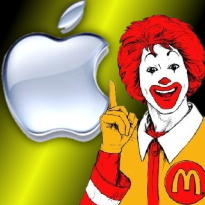 Last month, Apple announced that its App Store had, in its three years of operation, notched over 15b downloads. (With 200m+ iOS users, that’s an average of 75 apps per.) As of June, Google’s Android Market has tallied 4.5b downloads. ZDNet’s Eric Lai decided to compare these figures against the sales of McDonald’s hamburgers, “the gold standard for incredible growth.” (And he’s not just talking about those tumors in your colon.)
Last month, Apple announced that its App Store had, in its three years of operation, notched over 15b downloads. (With 200m+ iOS users, that’s an average of 75 apps per.) As of June, Google’s Android Market has tallied 4.5b downloads. ZDNet’s Eric Lai decided to compare these figures against the sales of McDonald’s hamburgers, “the gold standard for incredible growth.” (And he’s not just talking about those tumors in your colon.)
According to Lai’s research, McDonald’s took 26 years to sell 15b of those craptastic burgers, and 20 more years to earn their ‘100b sold’ bragging rights. Apple has thus hit their 15b download mark 9x faster than Rotten Ronnie’s 15b sold, and could reach the 100b mark 9x faster as well. Analysts have pegged App Store downloads to grow by 61% this year. Based on current projections of Android device sales, Lai estimates that Google could reach 100b downloads even faster than Apple.
We can think of no better segue than going from McDonald’s sales counter to the nearest toilet. According to the International Telecommunication Union (ITU), there are currently more than 4b mobile phone subscriptions in the world’s ‘developing countries.’ At the same time, the ITU estimates that 2.6b people in these same countries lack “access to toilets or other forms of improved sanitation.” Mobile phone penetration in the developing world reached 70% at the end of 2010, six years after the developed world reached the same figure. Mobile phone penetration in Africa was 45.2%, compared to 69.2% in the Asia-Pacific region, 94.5% in the Americas and 117.7% in Europe. In 2002, only two countries had mobile penetration higher than 100%, compared to 97 countries in 2010.
The ITU also tallied rates of internet user penetration. In the year 2000, 72 different economies across the globe had internet user penetration rates below 1%. By 2010, internet user penetration across the developing world had hit 21%, and the number of economies scoring under 1% had dropped to six. In 2010, internet user penetration in Africa hit 10.8%, compared to 22.5% across the Asia-Pacific region and 67% in Europe. The global figure was 30%, a mark the developed countries hit way back in 2001. Sadly, ITU neglected to report how many of these internet users were accessing either McDonald’s nutrition info sites or (immediately thereafter) Googling directions to the nearest poison control center.